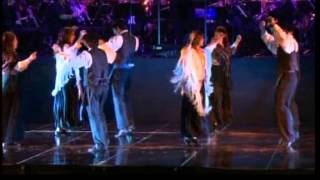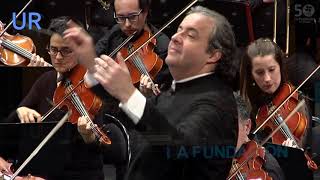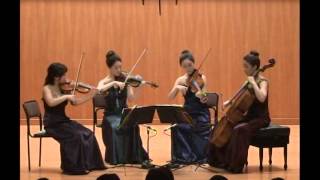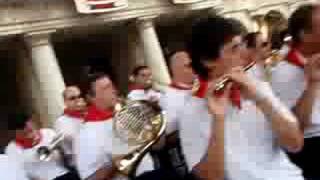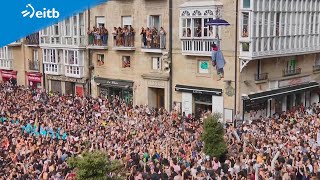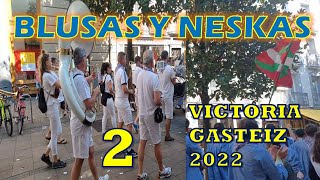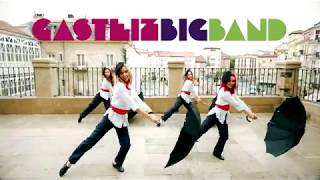On August 4 began the Festivities of the White Virgin of Vitoria-Gasteiz
The atomic bombings of Hiroshima and Nagasaki took place on August 6 and 9, 1945.
Recommended music videos for initiation to classical music
The Fiestas in honor of the Virgen Blanca , have been celebrated in Vitoria-Gazteiz since 1884 and begin the day before, on August 4, in the Plaza de la Virgen Blanca , located in the heart of the city, where thousands of people from Vitoria and Visitors gather to start the festivities with the descent of Celedón . The celebration of festivities in honor of the Virgen Blanca goes back to very distant times; Until 1883, events were held under the name of " Fiestas de Vitoria ", which took place during the first week of September. As of 1884, after a municipal agreement, they began to be celebrated on August 5, in honor of the White Virgin . In 1953, the municipal corporation established the festive calendar as it is known today.
José Luis Ruiz de Gordoa , author of the music for Badator Zeledon , is a composer and teacher born in Araia (Álava-Araba), on February 23, 1957. He began his musical studies at the Vitoria-Gasteiz Conservatory . Later he continued those of harmony in Pamplona with Aurelio Sagaseta and Pedro de Felipe ; those of counterpoint and fugue in Bilbao with Juan Cordero , and those of composition, first in Madrid with Antón García Abril and Román Alís and, in Vitoria-Gasteiz , with Carmelo Bernaola . He has worked conducting the orchestra with Enrique García Asensio . He is a professor of counterpoint and fugue at the Jesús Guridi Conservatory in Vitoria-Gasteiz . He is the author of various works of various genres. ( Extracted from Auñamendi Eusko Entziklopedia )
The atomic bombings of Hiroshima and Nagasaki were two nuclear attacks ordered by Harry S. Truman , President of the USA , against the Empire of Japan . The attacks took place on August 6 and 9, 1945, contributing, along with the Soviet-Japanese War, to Japan 's surrender and the end of World War II . After six months of heavy bombardment of 67 other cities, the Little Boy nuclear weapon was released on Hiroshima on Monday, August 6, 1945, followed by the detonation of the Fat Man bomb on Thursday, August 9, on Nagasaki . It is estimated that, by the end of 1945, the bombs had killed 166,000 people in Hiroshima and 80,000 in Nagasaki , totaling about 246,000 deaths, although only half died on the days of the bombing.
Andrew Lloyd Webber (1948) is a late 20th century composer, writer, author, producer, director and director of numerous plays. He has produced 16 musicals, two soundtracks and a Requiem mass in Latin. His awards include three Tonys , three Grammys , an Oscar , an Emmy , seven Oliviers , and a Golden Globe . Some of the songs from his plays, such as Don't Cry For Me, Argentina (from Evita ) and Pie Jesu (from his Requiem Mass ) have been successful in Europe and America outside of stage performances and have been sung by many artists. Some of his musicals like Jesus Christ Superstar, Evita, The Phantom of the Opera and Cats have been brought to the big screen with great success.
Pie Jesu is a text from the final couplet of the Dies irae that is often included in musical versions of the Requiem Mass as a stand-alone motet . Andrew Lloyd Webber 's version in his Requiem (1985) performed by Sarah Brightman and Paul Miles-Kingston (version we offer today), was a certified Silver hit in the United Kingdom in 1985. The translation of the text says: " Merciful Jesus, who takes away the sins of the world, give them rest."
Ludwig van Beethoven (1770-1827) together with Bach and Mozart is part of the trio of giants of Western music. Born in Bonn , his father, of Flemish origin, tried to make a second Mozart of him, though it was a notable failure. Despite this, from the age of nine, the organist Christian Gottlob Neefe captivated him with the study of Bach , whom he would always keep in mind. In 1787 he moved to Vienna with the intention of receiving Mozart classes, but the death of his mother brought him back to Bonn after a few days. And so after five years, he returned to Vienna where he made contact with Haydn and Salieri , making himself known as a composer and pianist with well-known public recognition. However, his profession as a pianist could not be carried out due to the deafness that attacked him the following year until he was totally disabled from said faculty.
Beethoven 's Sonata No. 14 op 27 No. 2 popularly known as "Moonlight" is one of his most famous works along with "For Elisa" and the fifth and ninth symphonies . It was composed in 1801 and published the following year in Vienna . Today we offer the third Movement Presto agitato , which is an experiment by Beethoven and is written in sonata form . The movement consists of rapid arpeggios, scales, and skillful question-and-answer play between the two hands. Its difficulty is very high and contrasts with that of the two previous movements.
Anastasia Huppmann (1988) is a Russian pianist born in Tver who began her piano studies at the age of five; at the age of six she was treated as gifted, delving into the studies of music theory, piano and composition; At seven, he appeared on television playing his own compositions and at eight, he won his first piano competition, which, throughout his career, would be followed by a few more, which has earned him performances in the most important venues in Europe . and Asia .
Jesús Guridi (1886-1961) was born in Vitoria-Gazteiz into a musical family. After the family moved to Madrid , Guridi entered the Conservatory ; However, the economy did not go well for the parents, so they moved to Bilbao , where thanks to the patron, the Count of Zubiría , he was able to move to Paris and enter the Schola Cantorum to study piano, organ, counterpoint and composition. After finishing his studies, he went through Belgium , Cologne and Munich to deepen them. Back in Bilbao , at the age of 21, he took over as director of the Bilbao Choral Society , a job that he combined with that of organist in the Basilica (now the Cathedral) of Santiago . In 1939 he returned to Madrid , as director of the Conservatory , where he would die at the age of 75.
El caserío is a zarzuela from the early 20th century written by Federico Romero and Guillermo Fernández-Shaw , with music by Jesús Guridi . It premiered at the Teatro de la Zarzuela in Madrid on November 11, 1926. El caserío is a lyrical comedy in three acts of costumbrista character, where life in a contemporary Basque peasant village is exposed. Much of the music is inspired by Basque folklore. It is one of Guridi 's most important compositions. It is located in the imaginary village of Arrigorri , in Bizkaia. Typical characters are presented in a stereotyped way: the priest, the mayor, the secretary, the rich Indian, the tavern keeper...
The version that we present today is conducted by the Gipuzkoan maestro José A. Irastorza .
Recommended classical music videos
Bingen Mendizabal (1962) is a Basque musician born in Vitoria-Gasteiz , composer of film soundtracks. In 1969 he entered the Jesús Guridi Conservatory in Vitoria-Gasteiz , where he studied violin with Albina Madinabeitia and composition with Carmelo Bernaola , and also learned with Luis de Pablo and Antón García Abril . A lover of traditional Basque music and Irish folk, he created his own group, Nahiko , and finally joined the Hertzainak group for a few years until it dissolved. After working for other musicians, he composed different soundtracks for Spanish and international directors. In 2008, he was nominated for the Goya for best original music for El juego del ahorcado .
The Vitoria-Gasteiz Symphony is a work commissioned by the San Prudencio Labor Foundation for its 50th anniversary. The work is inspired by the music of the composition that Beethoven dedicated to the Battle of Vitoria , his opus 91 also known as Wellington's Victory in which he defeated Napoleon precisely in Vitoria . Mendizabal says that this symphony is a gift to the city; a gift that has an Alava packaging, since, in addition to the composer, the orchestra is made up of musicians from Gasteiz under the baton of the maestro, also from Vitoria as well as internationally famous and appreciated, Juanjo Mena . The Vitoria-Gasteiz Symphony premiered on April 4 at the Teatro Principal in Vitoria-Gasteiz .
Wolfgang Amadeus Mozart (1756-1791) is considered one of the three giants of musical composition along with Bach and Beethoven . Child prodigy born in Salzburg (Austria), at the age of six he mastered the keyboard and the violin and began to compose. His father, Leopold exhibits him in exhausting tours of different European courts. A prolific composer (more than 600 works written from the age of five until his death), he cultivated all kinds of musical genres: piano works, chamber music, symphonies, concertante works, choral works, operas... each and every one of them, masterpieces of its gender. His operas The Magic Flute, Don Giovanni, Cosí fan Tutte, and The Marriage of Figaro are among the 10 most performed operas in the world. He died in Vienna at the age of 35.
The String Quartet no. 23 in F major, K. 590 , written by Mozart in 1790 and dedicated to Frederick William II , King of Prussia and an amateur cellist. It consists of four movements: I (0´06´´) ALLEGRO MODERATO .-. II (6´55´´) ANDANTE .-. III (12´48´´) MINUETTO: ALLEGRETTO .-. IV (16´50´´) ALLEGRO.
Today's version is brought to us by the Yul String Quartet .
Dionisio Aguado (1784-1849), Spanish classical guitarist and composer born in Madrid , is one of the most celebrated Spanish guitarists of the 19th century . He adopted the conventional notation for guitar, dispensing with the tablature notation, prevailing in Spain at that time. Napoleon 's invasion made him retire with his mother to their lands in Fuenlabrada and he dedicated himself to deepening his musical knowledge. After a period of retirement that he dedicated to the study and improvement of his technique, he went to Paris in 1825, and attracted the attention of relevant musicians of the time for his virtuosity, and achieved great success with his recitals. In 1838 he returned to Madrid , where he dedicated his life to teaching until he died on December 29, 1849.
The Rondó , round or dance in a circle is a profane musical form of the French Middle Ages based on the repetition of a musical theme that is characterized by the constant appearance of a chorus and a love text. Couperin defined it as a form that is based on "a main theme that reappears and alternates with different intermediate themes, called couplets ." The typical feature of any rondo is the return to the main theme after each digression, which provides contrast and balance, where the number and length of these are always different. These repetitions alternate with musical themes or episodes called contrasts (ABACA).
Today the young Russian guitarist teacher Valeria Galimova offers us the Introduction and Rondó Brillante Op. 2 No. 2 by Dionisio Aguado .
Krzysztof Penderecki (1933-2020) was a Polish classical composer and conductor, known for his compositional style, specifically recognizable in his atonal works, some of which have been used for famous films. He studied music at the Music Academy in Kraków under Artur Malawski and Stanislaw Wiechowicz . After graduating in 1958, he took a teaching position at the Academy . Penderecki 's early works show the influence of Igor Stravinsky, Anton Webern , and Pierre Boulez . His international recognition began in 1959 at the Warsaw Autumn Festival with the premiere of the piece Lament for the Victims of Hiroshima , written for 52 bowed string instruments.
Today we offer it in a version by the Finnish Radio Symphony Orchestra conducted by the Polish maestro Krzysztof Urbański .
Recommended music videos for all tastes
Mariano San Miguel Urcelay (1879–1935) was a composer, clarinetist and bandleader born in Oñati , Gipuzkoa. His first music theory teacher, and then clarinet, was his musician father; As a child he was already a member of the music groups of Professor Piedrahita and the Las Navas Battalion in Vitoria-Gasteiz . Founder in 1916 of the magazine Harmonía , dedicated to the publication of works for band, he returned to Vitoria-Gasteiz his adoptive homeland. He wrote the parade dedicated to the mythological character Celedón that was premiered in Vitoria-Gasteiz in 1918 by the Vitoria Municipal Music Band directed by José Gregorio Escoriaza. A street in Vitoria-Gasteiz has been named after him since June 8, 1960.
Celedón is the character whose arrival, coming down from the sky with an umbrella, opens the patron saint festivities of Vitoria-Gasteiz . Its festivities are celebrated in honor of the Virgen Blanca (Andre Mari Zuria), whose festival is commemorated on August 5. The festivities begin the day before with the Bajada de Celedón , which takes place in the Plaza de la Virgen Blanca before a large crowd that receives the character lighting cigars and opening bottles of champagne. From the top of the tower of the Church of San Miguel , at six in the afternoon, after throwing the chupinazo, Celedón comes down (a doll suspended by a rope) "flying" over all the people and with his umbrella open, he arrives to a balcony from which he comes out, already turned into a human to pass on this occasion walking through the crowd.
Nina Hagen (1955) is a German singer and actress, born in East Berlin when present-day Germany was divided into two states, famous for her mix of punk style and operatic singing . Her father died when she was just a child, and her mother married singer-songwriter Wolf Biermann , who was accused several times of being a counterrevolutionary in the then German Democratic Republic , for criticizing and mocking the regime. Nina learned ballet at an early age and demonstrated amazing ability as a singer, being considered a child prodigy for her opera performances. Today, Nina is considered one of the most innovative singers of the punk era.
Combo Y 25 is a jazz combo from the Jesús Guridi Conservatory , in Vitoria-Gasteiz (Araba), made up of Iñar Sastre (pianist, Repertoire teacher at the Conservatory, and creator of this Combo ), Martina González de Langarica (saxophone student ), Axel Yong Ortiz (electric guitar student) and Julen Ortiz de Zárate (percussion student). The nickname of Y 25 is due to the fact that when the students had the Combo class with their teacher, Inar , he would arrive "on time"... twenty-five minutes later. Up to now Combo Y 25 has had two performances at the Fundación Vital concert venue and another two at the Jesús Guridi Conservatory with works such as I got rythm , by George Gershwin , Yes or no , by Whaine Shorter , or Misty , by Errol Garner .
Kacey Musgraves (1988) With a slow, sweet and calm style. Frequently leaning on her guitar, she is an atypical American country music singer who frequently uses lyrics with social themes, such as the fight for the LGTBI collective, as well as different musical innovations. Despite her youth, she has garnered numerous Grammy Awards in 2013, 2014, 2015, and 2019.
Recommended peculiar videos
Life at parties . The festivities begin with the descent of Celedón , a doll that represents an old villager from Álava, and that crosses the Plaza through a system of pulleys; Upon reaching the balcony of the Church of San Miguel , already transformed into a living member of a band of blouses, the traditional aurresku is danced for him. This is how the Fiestas begin, which last from August 4 to 10, with the 5th being the Day of the White Virgin . The protagonists of these festivities are the gangs of blouses, groups of Vitorian people who, dressed in typical costumes, organize and star in numerous activities. Different shows, concerts and festivals are organized throughout the city and orchestras and brass bands circulate twenty-four hours a day.
And we close the Holidays with an updated version of the old Celedón , how could it be otherwise.
Datorren uretera art. gora zeledon
Recommended music videos for children
Various Wikipedia articles have been used to write these texts.
The texts of Videomusicalis are written in Basque, Spanish and English.





